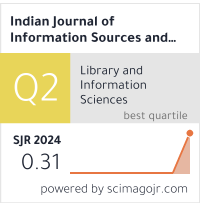Use of Electronic Information Services in the Visually Impaired Libraries
DOI:
https://doi.org/10.51983/ijiss.2015.5.1.421Keywords:
Electronic Information, Assistive, Braille, Visually impaired, Screen reader, scanner, softwareAbstract
The Libraries need to be committed to ensure full access of their range of services and facilities to their user community. Visually impaired have limited opportunities to access information especially those available in print. The Visually impaired library in India depend on two basic sources for their information one is Braille books and other is Talking book services. This study also Libraries /centers on meeting the reading needs of person with visually impaired through various assistive technology devices which include Braille Printer, Low Vision aid, Screen Reader to help them to achieve their education. Information Technology is an important tool in the inclusion process and can promote independence and autonomy of students with visually impaired Libraries.
References
Babalola, Y. T. (2011). Library and information services to the visually impaired - the role of academic libraries. Canadian Social Science, 7(1), 140-147.
Brazier, H. (2007). The role and activities of IFLA Library for the Blind Section. Library Trends, 55(4), 864-878. Retrieved November 5, 2014, from http://muse.jnu.edu/journals/Librarytrends/vol.55.4/brazicr02.html.
Koganuramath, M. M., & Choukimath, P. A. (2009). Learning Resources Center for the Visually Impaired students in the universities to foster Inclusive Education. ICAL, 619-624.
Lucky, A. T., & Acheba, N. E. E. (2013). Information service delivery to the visually impaired: A case study of Hope for Blind Foundation Wusasa, Zaria (Nigeria). Research Journal of Information Technology, 5(1), 18-23.
Eskay, M., & Chima, J. N. (2013). Library and information service delivery for the blind and the physically challenged in University of Nigeria Nsukka Library. European Academic Research, 1(5), 625-630.
Broll, G., Keck, S., Holleis, P., & Butz, A. (2009). Improving the accessibility of NFC/RFID-based Mobile Interaction through Learnability and Guidance. International Conference on Human-Computer Interaction with Mobile Devices and Services, 11.
Kim, S.-Y., Park, B., & Jung, J.-J. (2011). User Route analysis of using GPS on a Mobile Device and Moving Route Recommendation System. The Korea Contents Associations, 11(2).
Comisco, J. (2008). Electronics text and visually impaired users: Standards and the move towards universal accessibility. Scroll, 1(1), 62-70. Retrieved September 6, 2014, from http://fdt.library.utoronto.ca/index.php/fdt/article/.../4903/1760.
Koulikourdi, A. (2008). Library services for people with disabilities in Greece. Library Review, 57(2), 138-148. Retrieved September 5, 2014, from http://www.emeraldinsight.com/journal.html.
Brazier, H. (2007). The role and activities of IFLA Library for the Blind Section. Library Trends, 55(4), 864-878. Retrieved September 5, 2014, from http://muse.jhu.edu/journals/libraryrends/vol55/55.4brazier02.html.
Eskay, M., & Chima, J. N. (2013). Library and Information Science Delivery for the Blind and physically challenged in University of Nigeria Nsukka Library. European Academic Research, 1(5), 625-635.
Downloads
Published
How to Cite
Issue
Section
License
Copyright (c) 2015 The Research Publication

This work is licensed under a Creative Commons Attribution-NonCommercial-NoDerivatives 4.0 International License.









